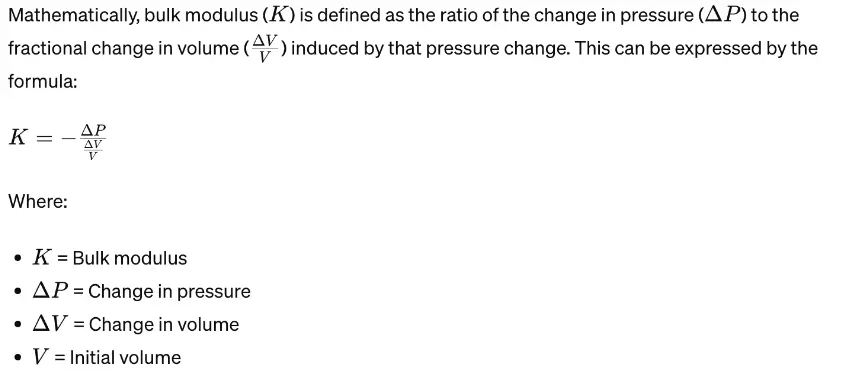In the realm of physics and materials science, understanding how materials respond to external forces is crucial for numerous applications ranging from engineering to geophysics. One fundamental property that characterises a material’s response to compression is its bulk modulus. Bulk modulus, denoted by the symbol K, is a fundamental parameter that quantifies a material’s resistance to uniform compression. It is an essential concept in various fields, including physics, engineering, and materials science.
Introduction to Bulk Modulus
Bulk modulus is a measure of how resistant a material is to compression under hydrostatic pressure. When a material is subjected to an external force that tends to decrease its volume uniformly, bulk modulus quantifies the material’s ability to withstand this change. It essentially describes the stiffness of a material when subjected to changes in volume due to external pressure.

Mathematical Definition
Significance in Materials Science
Bulk modulus is a fundamental property that determines how materials respond to external pressure. Materials with high bulk modulus are difficult to compress, while those with low bulk modulus compress more readily. This property is crucial in various engineering applications, including designing structures, understanding material behaviour under stress, and selecting materials for specific purposes.
Relationship with Elasticity
Bulk modulus is closely related to a material’s elasticity. Elasticity refers to a material’s ability to return to its original shape after deformation. Materials with high bulk modulus tend to be less elastic, meaning they deform less under stress and return slowly to their original shape when the stress is removed. Conversely, materials with low bulk modulus are more elastic and deform more readily under stress.
Applications
- Engineering Materials Selection: Engineers consider bulk modulus when selecting materials for specific applications. For instance, materials with high bulk modulus, such as steel or diamond, are preferred for applications requiring stiffness and resistance to compression, like building structures or manufacturing tools.
- Geophysics: Bulk modulus plays a crucial role in understanding the behaviour of materials under high pressures, such as those found deep within the Earth’s crust. It helps geophysicists interpret seismic data and infer properties of subsurface materials.
- Materials Testing: Bulk modulus is often measured experimentally using techniques such as hydrostatic compression or ultrasonic testing. These measurements provide valuable insights into a material’s mechanical properties and behaviour under pressure.
- Acoustics: In acoustics, bulk modulus influences the speed of sound in a medium. Materials with higher bulk modulus transmit sound waves more quickly than those with lower bulk modulus.
Conclusion
Bulk modulus is a fundamental property of materials that quantifies their resistance to compression under hydrostatic pressure. It plays a crucial role in various fields, including engineering, geophysics, and materials science. Understanding bulk modulus helps researchers and engineers design structures, select appropriate materials for specific applications, and interpret seismic data. As technology advances, further research into bulk modulus and its applications will continue to enhance our understanding of material behaviour and contribute to the development of innovative technologies.




